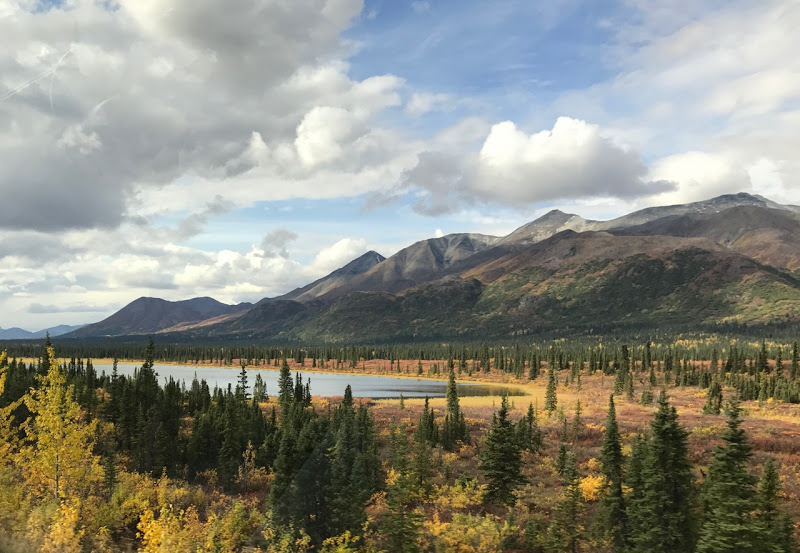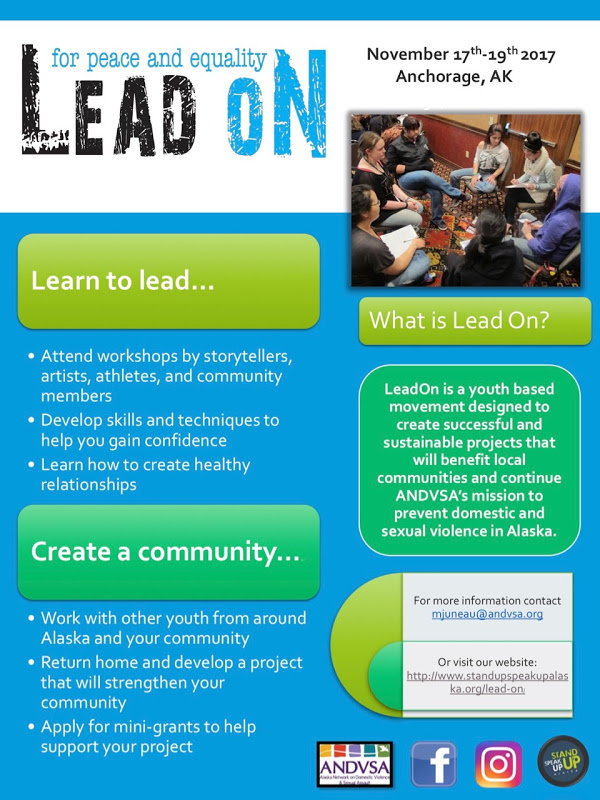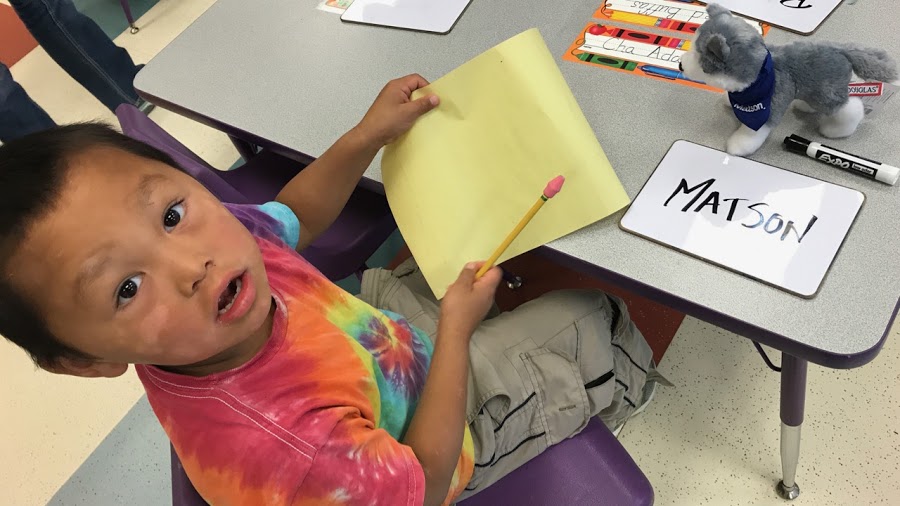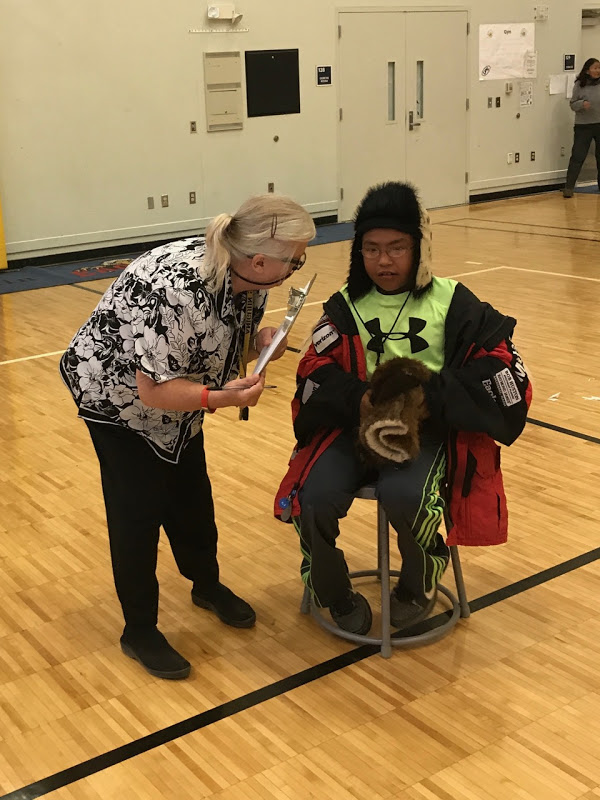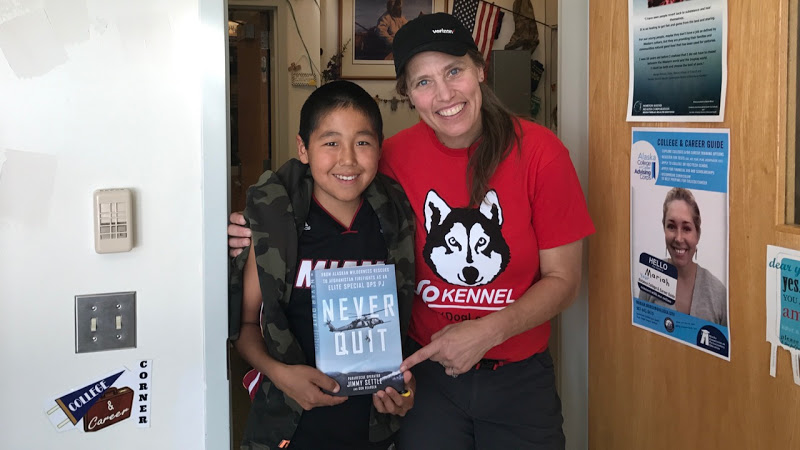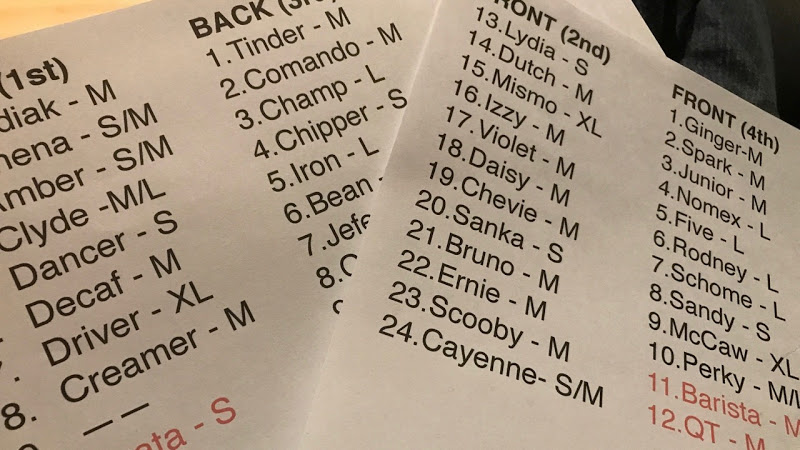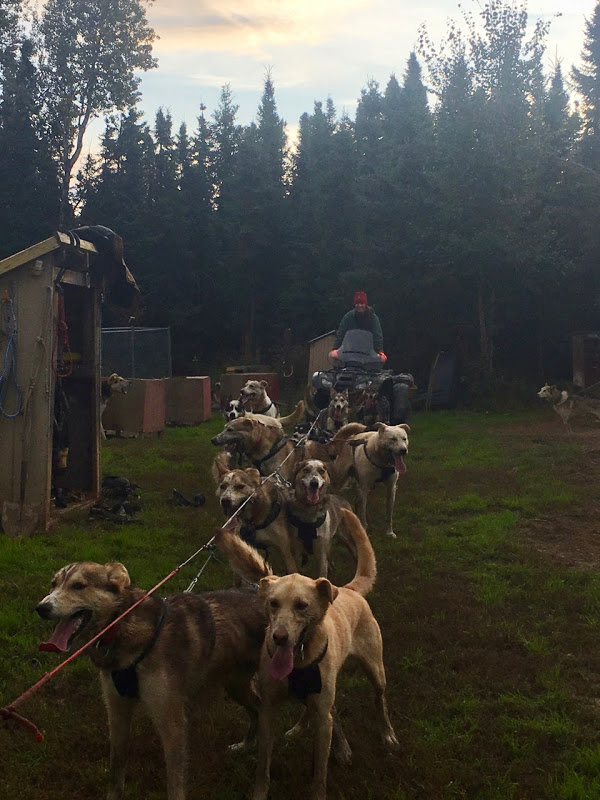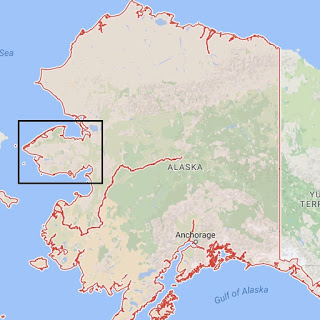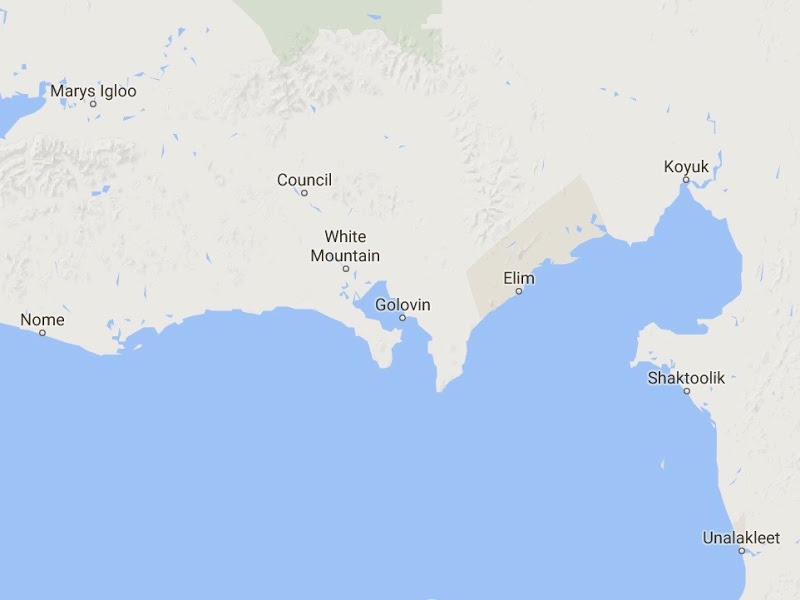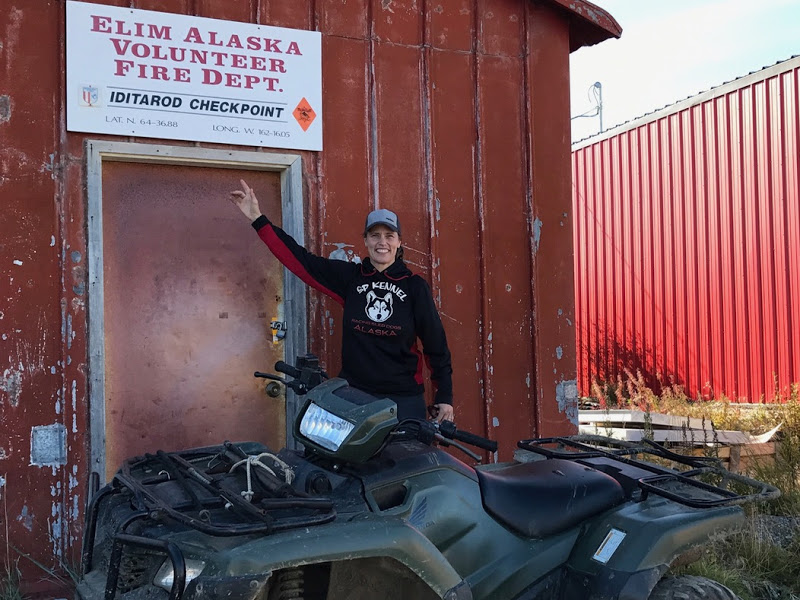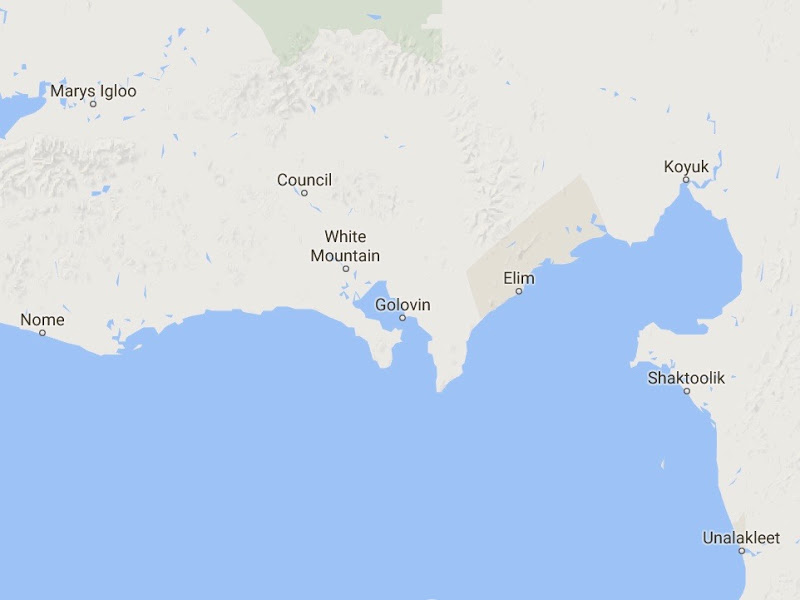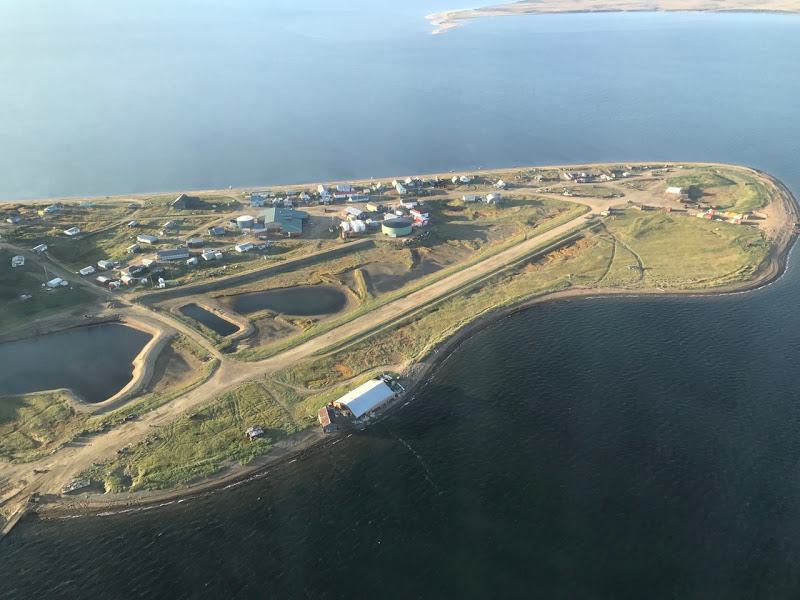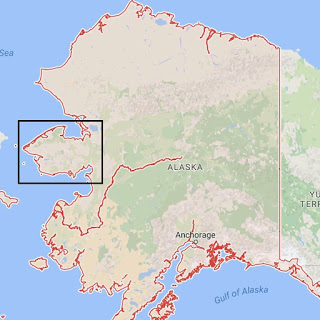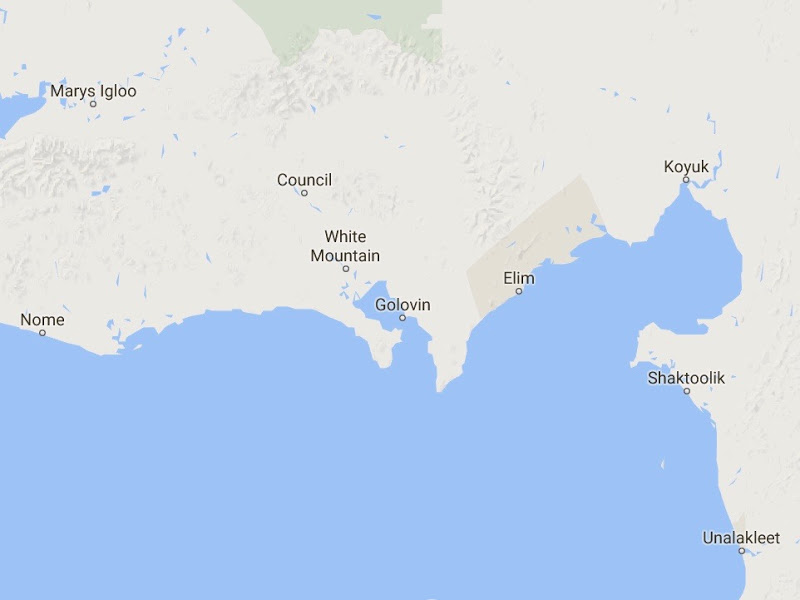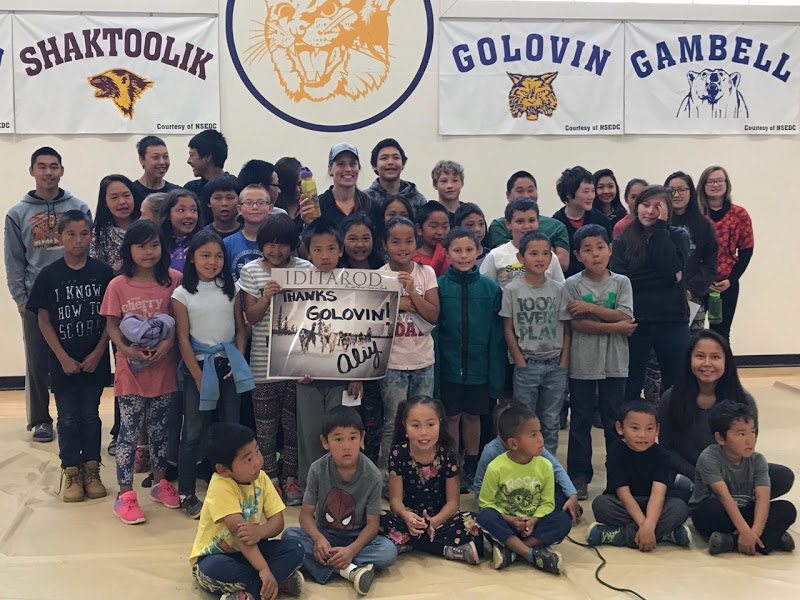In some areas of interior Alaska the fall colors are at their peak. In and around Two Rivers, the reds have faded but the yellows are still gorgeous.
Lead On Workshop
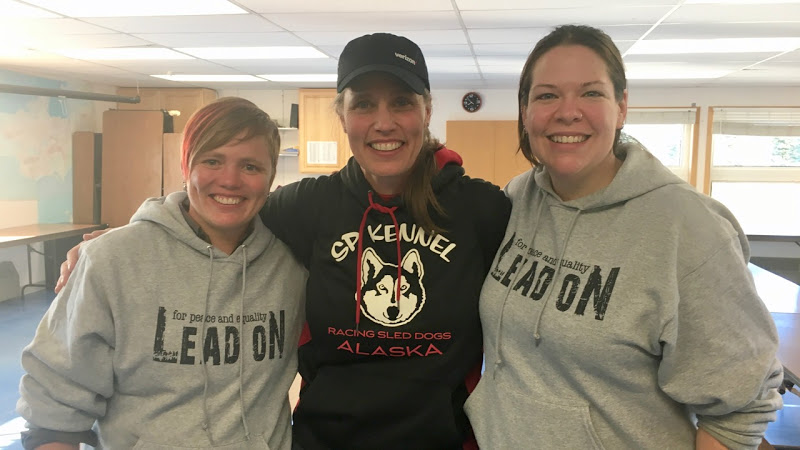
Rachel, Aliy and Megan in White Mountain.
Matson and I are part of a program that focuses on reducing domestic violence and sexual assault in Alaska. Our goal was to enable youth from bush Alaska to attend an educational workshop: Lead On!
The workshop focuses on youth personal empowerment and leadership skills. It is held in Anchorage in mid November. During my trip to the Western Coast of Alaska I brought the workshop organizers, Rachel and Megan, with me.
While I spent much of my time playing with stuffed toy huskys, reading books to first graders and running Iditarod Spelling Relay Races with middle schoolers, Rachel and Megan talked to teenagers about the workshop. There is a lengthy application for Lead On! But, before we left, some youth were already filling it out. Applicants should know fairly soon if they are accepted to the program. Due to Matson’s generous contributions, several teenagers from Golovin, Elim and White Mountain should financially be able to attend.
Where is Mac?
Now that the ‘Dog Page’ on the Dog Log is somewhat unavailable on line, it is not as easy to follow the stories while looking at the individual dog portraits and stats. We hope to fix that when the new website comes on line. But… until then: Who is currently in training?
We have been training 4 to 6 teams in the mornings. We are up and harnessing before daylight (sunrise was 6:50AM this morning.) The temperatures have been between 38 and 45 degrees Fahrenheit. Certainly not cold, but manageable with water breaks.
One dog who is not training with SP Kennel this season is Mac.
Mac moved in with Wes and Wendy during last season when it became obvious that his overheating issue was a long term condition. A true bummer for the SP Kennel race enthusiast. But, a awesome pet dog addition for the Brightmans. And although Mac might miss his time running in harness, he clearly enjoys his solo playtime, constant ear rubs and special attention.
From Wes and Wendy:
“Big Mac”, “Mac-a-doodle”, “Mac Daddy”. Everyone seems to have their own name for the popular and biggest dog in the SP Kennel yard. It’s amazing to see how small he was once upon a time. This spring, Aliy and Allen decided it was time for Mac to retire from racing.
Mac has had a wonderful career, retiring with three Yukon Quest championships and Iditarod top finishes under his harness. We were very excited to welcome Mac to our 5 acre farm. He starts each day with a morning patrol around the borders of the farm, checking on the overnight activities of the fox, moose, grouse, or squirrels; sniffing the peony flowers to see if they are ready for harvest. This is followed by a brisk run down the dog sled trail and around the moose pond. After breakfast, it’s a nap in the sun on the rug.
On very special days, (hot, sunny, summer days), Mac enjoys a swim in the pond. Yes, I did say “swim”. Generally, Alaskan Huskies aren’t crazy about getting wet. So what a surprise, when a few summers ago, Mac plunged into the water swimming after Tig the Labrador. Apparently he spent several summer walks watching Tig swim in the slough and thought it would be a great thing to try. Mac’s athletic build, large paws, and competitive nature make it a very entertaining sport for him.
Two weeks ago was special as Mac turned 8 years old on August 21. To celebrate, Mac had a trip to the pond, where he enjoyed a cool swim and a game of fetch. We are impressed with his diving skills, and included a video for you to admire.
Fall training has already started. Dog teams go past our house often. Mac watches each one, studying their technique, and barking out critiques to the young pups. We aren’t sure how he’ll react to a full season of watching teams on the trail, yet he seems quite content watching from a rug in the warm house. – Wendy/Wes
Western Alaska Recap
This is Aliy… checking in. The trip was amazing. Seriously amazing. I was extremely fortunate to be welcomed with open arms and big smiles to Golovin, Elim and White Mountain. It is hard to talk about each village in one post because they are three unique towns with their own spectacular individuals. But, I’ll try.
My school presentations were fun and exhausting. I spent all day at each school. I told my sister, who is the librarian at Two Rivers Elementary, that I can not imagine teaching every single day. Running Iditarod is tough but keeping up with the enthusiastic youth of Alaska is nearly impossible.
I read books to the youngest students. My favorite book to read the 1st through 2nd graders was the Itchy Little Musk Ox by Tricia Brown. It was especially poignant as there was a small herd of musk ox across Golovin Bay while I was there. I should mention that all the books I brought to the villages were purchased by ExxonMobil – so a big thanks to them!
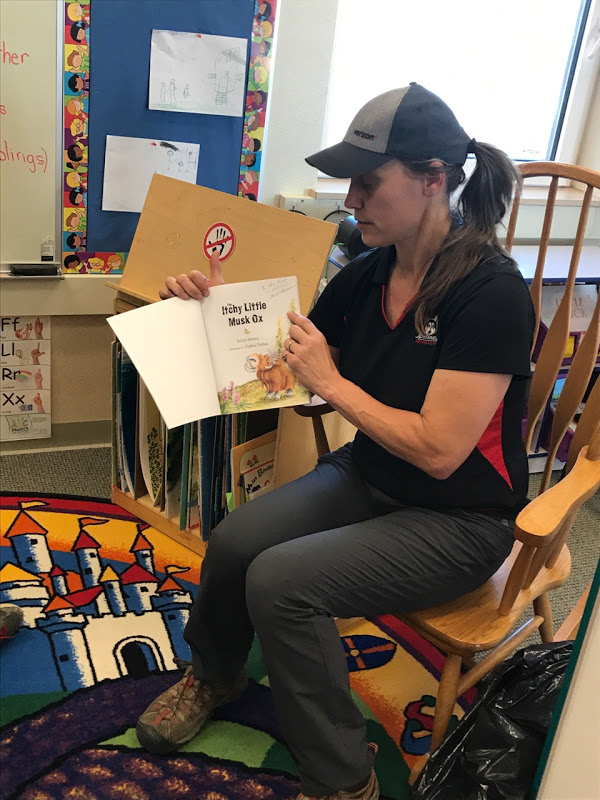
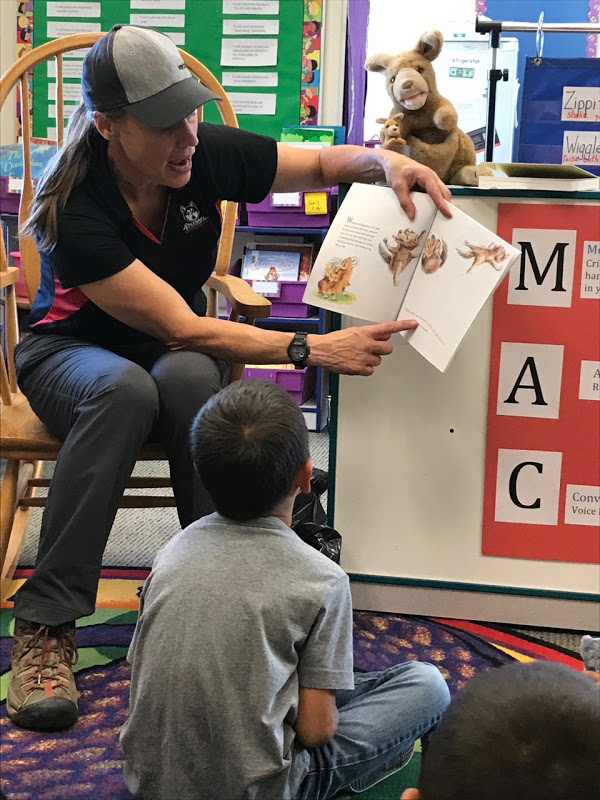
Tricia Brown autographed her book for ‘the herd in Golovin’; The kids loved it!
After the book reading, I asked the kids if they wanted to hear the names of my dogs. I got a resounding: YES!
After naming my dogs, I handed out a stuffed toy husky to each youngster K to 2nd grade (we had enough for Golovin and Elim.) The deal that I made with most of the youngsters is that they had to come up with a name for their pup. Then they could only bring home their pup if they wrote its name on a sheet of paper and gave it to me. Fair, right?
The names of the pups from the Golovin Kindergarten class are: Balto Sparky Moses, Sparky Balto Moses, Annie, Snowflake, Beauty, Max, KingKong and Douglas.
The names of the pups from White Mountain Kindergarten to 2nd grade are: Max, Kyeary, Apex, Raf, Champ, Steel, Teeny, Scooby, Strong, Bruno, Cinderella, Max(2), Nicole, Pink and Molly.
I didn’t get any names from any preschoolers.
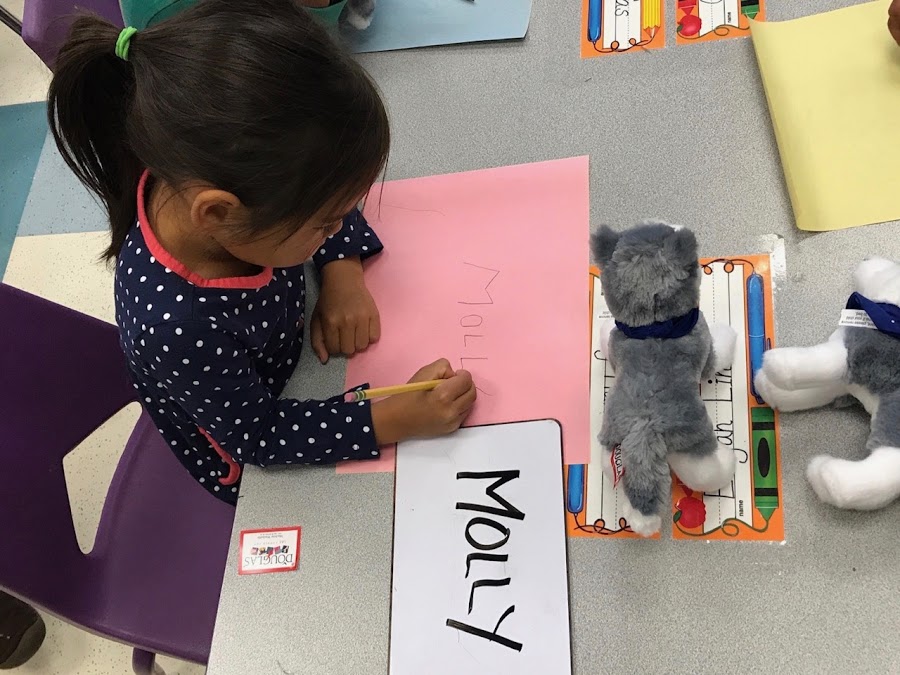
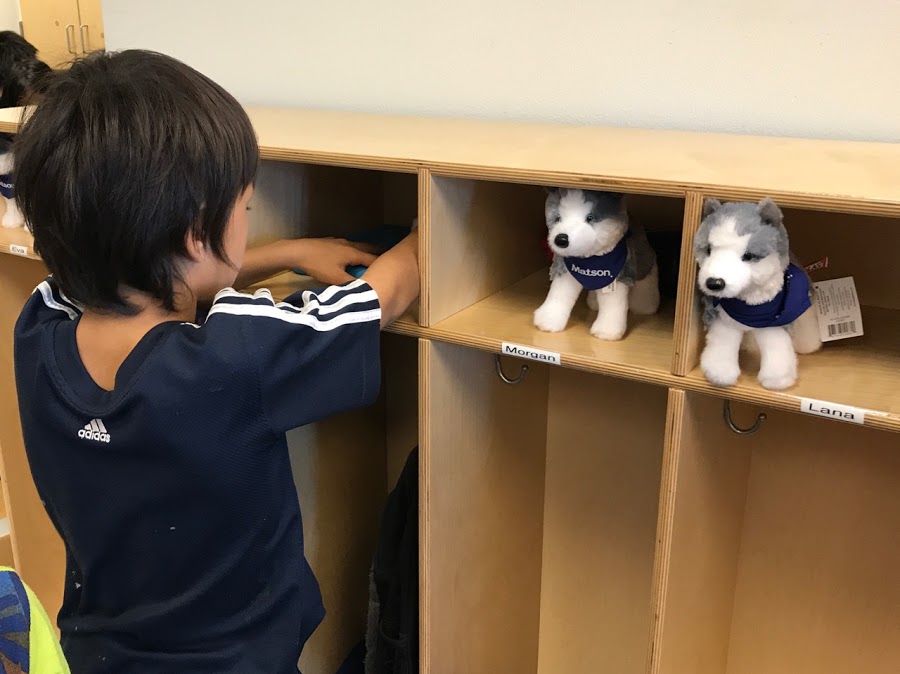
This pup is Molly; Pups stayed in ‘kennels’ until they were brought home.
I enjoyed all the names but “Matson” stood out the most since my sponsor, Matson shipping, was the one who donated these toy stuffed huskys. Thanks Matson! They were more of a hit that you could imagine.
I didn’t know that 3rd to 5th graders had as much energy as they do. If I did I would not have planned a “Iditarod Spelling Relay Race” at every school. I am not in my ‘best fitness’ currently so the relays wore me out. But… they were extremely fun. First off, I split up each class into random teams named: Kodiak, Commando and Scooby.
3-2-1 GO!
A child has to dress up in my mushing parka (yes… the real one), put on my fur hat and fur mitts. Then they (and I) raced together through willow bushes (other children with their hands in the air) to a chair on the other side of the gym. After sitting down, each kid needed to spell a word correctly then we ran back through the bushes (the bushes were a little more challenging to navigate than regular willow bushes with grabbing hands and tripping feet!) Each competitor then handed my mushing gear off to the next child on their team. We timed the teams and had 1st and 2nd (and sometimes 3rd.) Every team got awesome awards: Iditarod buttons and stickers. Thanks ITC for that donation!
There were not a lot of middle schoolers in any of the villages. But, I enjoyed sharing my personal videos from Iditarod as well as some of the Iditarod Insider videos. The ITC activated the schools’ Insider accounts so that I could show past videos. Everyone enjoyed watching me camped on the sea ice between Shaktoolik and Koyok! If they didn’t realize that I was crazy before that, they did then! I handed out books to these kids as well as Iditarod buttons.
The high school kids are a tough and independent bunch. Sadly, I didn’t have much time with them in Golovin. In Elim, they sat in on my community talk which basically talked about my amazing run of 2nd places finishes. But in White Mountain I had just a little more time and I talked for an hour to 8th through 12th graders. Many of us remember high school as a challenging time. Lots going on with our heads, our bodies and society catches up to us (or we catch up to it). Anyhow, the White Mountain youth were incredibly thoughtful as they asked me questions about how it really felt to come in 2nd place by 2 minutes and 22 seconds. They also asked the about the attack on me on the Yukon River last year. I was sincere in telling them that a victim never forgets, we bring our experiences along with us for the rest of our lives. It’s often very tough to view our negative experiences in a rational manner even though most of the world is a rational place. I will never forget what happened during the attack and I won’t downplay it either. It is simply a part of me now.
I did have several books for the high schoolers. The book that seemed to have much significance was “Never Quit” by Jimmy Settle and Don Rearden. As it turned out Don donated the books to my trip as well as autographing them for each village. This meant a lot to the kids. One teenager came running back in the room with the book pointing to Don’s autograph. Pretty cool!
Even though I may not have spent enough quality time with the high school kids, I was joined on this trip by two women from the Lead On! Workshop. Rachel and Megan spent a great deal of time speaking about healthy relationships, peer pressure and challenges of being a teenager. They also handed out applications to anyone interested in attending the Youth Leadership Conference in November. There are two scholarships available for each of the three villages. I sure hope that six kids decide to attend because we need some more Alaskan leaders from Western Alaska!
One final comment:
I have a soft spot in my heart for Golovin. For 17 years I have come through this little town with my dog team. I always thought that I had done my best to greet everyone who stood out and welcomed me. But, Golovin is not a Checkpoint so as racers we spend very little time there. While visiting, I actually timed me walking through Golovin along the Iditarod Route and it took only 5 minutes and 37 seconds to get through town at 3mph. So imagine a dog team trotting at even 7 mph. We are literally in and out of the little village in no time. Here is the iditarod route in the summer time. I sped it up to 7.5 mph “dog team” sped (with a little bit of mathematical assistance from my dad) and here you go. This is how long it takes an Iditarod Dog Team to realistically travel through Golovin:
Anyhow, on my Golovin visit a woman approached me and said that her 9 year old son was very upset that he had asked for my autograph this year and I hadn’t give it to him. She said; “I guess you were in a rush.” I was shocked, embarrassed and upset. I guess I wasn’t surprised but it pained me to think that I had been so callous.
I asked where I could find her son. I didn’t know what I could do to make up for this stupid and insensitive mistake. When she brought me to him, he whispered in her ear. She stood up and said “I’m sorry, he said that he did get your autograph… it must have been someone else.”
I can not describe the few minutes of utter shame that I felt when I thought I had ignored the small request of a 9 year old Iditarod fan. Trust me when I say: I will never let that happen. If I come in second place (again) due to the fact that I stopped for 2 minutes in Golovin to sign a poster, it will feel no worse than I did for those few minutes in Golovin.
First Day in Harness for this Season
September 1st and it was 43 degrees F at 5:45AM. (That’s 6 degrees C.) Perfect for Fall training.
Only Nutmeg, Bullet and Tig sat out this morning. Aliy, Allen, Wes and Jeff plus every other canine at SP Kennel took part in the training.
Some of the older, yet active dogs, were mixed in on the last team to run this morning. This isn’t the best video we have ever produced… but you get the idea! Here we go:
White Mountain is a Cheerful Spot
From a Musher’s perspective:
It is a long, challenging run across Golovin Bay no matter what. The flat terrain (because it is the frozen ocean) has very few reference points to judge distance or depth. There are often no distractions for the dogs or Mushers. At this point in the race, distractions are nice.
Finally, the route comes off the ocean, overland and onto the Fish River. The teams generally gain enthusiasm from the terrain change, the windy river and veteran dogs know that just around the next corner… is White Mountain!
The final 1/4 mile into the Checkpoint, both dogs and Mushers can see dozens of village houses along the bluff above the river. Day or night, this is an exciting moment. Village dogs bark and spectators will yell and whistle.
Teams are parked on the frozen river. The village of White Mountain is spread out above them.

Boats are parked where the Iditarod Dog Teams usually park.
White Mountain is one of the best towns in the world for sledding downhill and the kids use sled, plastic, cardboard or their fannies to enjoy themselves. Villagers – youth and adults – come down to the parking area to see the teams come in and leave. The attitude of the Mushers is much different here than anywhere else on the route. A mandatory 8 hour rest stop means that no one has to make any strategic decision and no one can ‘sneak out’ before they are supposed to leave. Both Aliy and Allen enjoy White Mountain tremendously.
Aliy was in White Mountain all day Wednesday, August 30th.
Elim is Wonderful
From a Musher’s perspective:
An Iditarod dog team is nearing the village of Elim after it reaches Moses Point. Moses Point is a summer fish camp along the ocean that is completely abandoned in March. After the trail passes by fish nets decorated with icicles and boats upturned to the weather, it gets on an unplowed road leading to Elim.
The road is very protected and there are even trees and bushes that add a sense of security if windy conditions arise. But there are also many hills along the trail between Moses Point and Elim. For a tired dog team these hills are huge mountains, for energetic teams this are just small mounds. At the crest of the last hill driveways appear on both sides of the road and the teams are usually greeted, day or night, by barking dogs. “Who is in my neighborhood?”
The trail then runs downhill and into the heart of the village. The Checkpoint building is in the village Firehall surrounded by houses and cabins. The people of Elim come to see the Mushers and visit and talk about trail conditions and weather – always important topics! Aliy usually stays in Elim just long enough to take a quick nap and feed the team a big meal. Allen and the Black Team will stay longer and enjoy the hospitality.
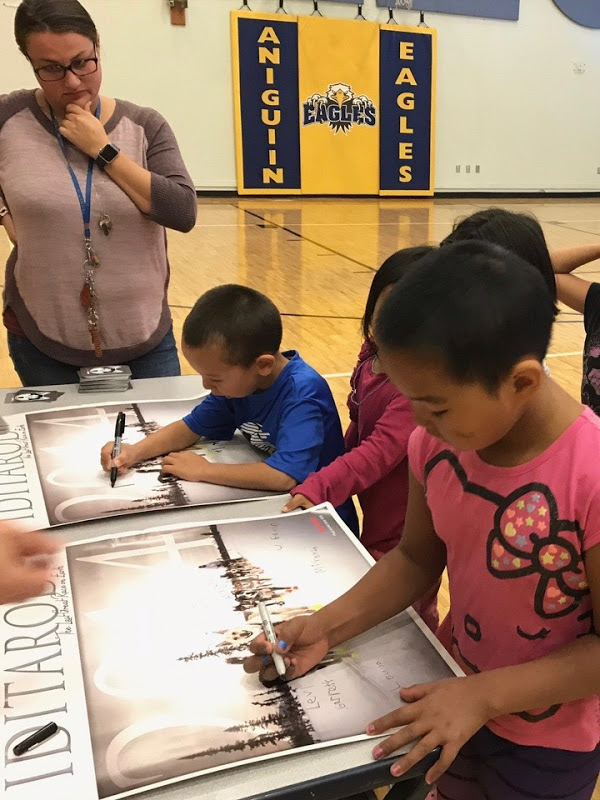
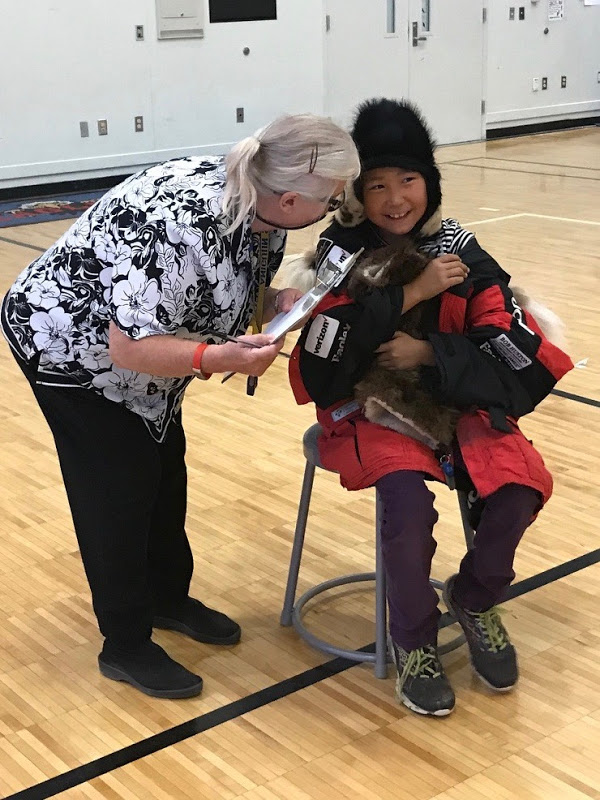
Aliy asked everyone to sign Iditarod Posters; Spelling Bee “Iditarod” Relay.
The exit trail from the Elim depends on how thick the sea ice is. Some years the ice is poor or nonexistent along the village shoreline so the route will follow the Old Mail Trail on land and through the hills. If the ice is good, then the trail leaves Elim directly onto the frozen sea and parallels the shoreline until leaving the sea to climb Little McKinley.
Aliy will be in Elim all day Tuesday, August 29th.
Golovin is a Special Place
From a Musher’s perspective:
The little town is a bit of a hurdle near the end of the race. From high above Golovin, a Musher can look down from the summit of Little McKinley. It is visible from very far off, down and across the frozen bay. The route down to the bay can be treacherous, along a slippery side slope often accompanied by gusty winds. There is a small shelter cabin half way down the mountain. Besides that small shelter, there are no trees, rocks or hummocks to hide from the weather. Once the trail reaches the frozen ocean, the conditions can vary. On ‘easy’ years there is plenty of snow cover on the sea ice and the trail markers show the way across the bay into town. On ‘challenging’ years there is no snow on top of crystal clear and smooth sea ice. Neither the dogs nor Mushers have traction and wind gusts have pushed entire teams miles across the bay to the shoreline on the far side. Dog teams have also stalled out here on the frozen ocean. It can be an intimidating place.
From several miles out on the sea ice, during the day, the colorful village houses stand as contrast to the white winter landscape. During the night, the welcoming glow of “city” lights spreads across the horizon. A dog team gets excited day or night.
Upon reaching Golovin, the race route climbs up off the bay and enters the center of the small town. More often than not, children stand at the spot that Mushers come of the sea ice and greet them. Some Mushers stop, some Mushers don’t. Aliy and Allen always stop. They enjoy the welcome and sign posters, jackets, give hugs and say “Howdy!”
Usually, only minutes later, the teams are ready to go. The route follows the main street through the middle of town. Often there are people, dogs, travelers or perhaps… no one. A few hundred yards later the route turns sharply left, off the street and zigs across a clearing then drops back down onto the sea ice. Golovin is now behind.
Iditarod Mushers do not generally spend any more than the few minutes it takes to travel down Main Street.
Aliy will be in Golovin all day today, Monday, August 28th.

